Themed collection In celebration of Seiji Shinkai's 70th Birthday

Hierarchical supramolecules and organization using boronic acid building blocks
Current progress on hierarchical supramolecules using boronic acids has been highlighted in this feature article. The feasibility of the structure-directing ability is fully discussed from the standpoint of the generation of new smart materials.
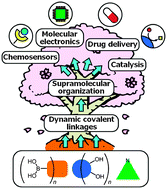
Chem. Commun., 2015,51, 2005-2020
https://doi.org/10.1039/C4CC07712A
Anion receptor chemistry: highlights from 2011 and 2012
This review covers advances in anion complexation in the years 2011 and 2012.
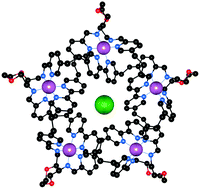
Chem. Soc. Rev., 2014,43, 205-241
https://doi.org/10.1039/C3CS60316D
Selective sensing of saccharides using simple boronic acids and their aggregates
Saccharide-selective supramolecular sensors based on boronic acids, with a focus on using self-assembly of multiple boronic acids to target multivalent saccharide analytes.
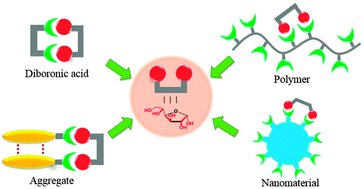
Chem. Soc. Rev., 2013,42, 8032-8048
https://doi.org/10.1039/C3CS60148J
Selective fluorogenic imaging of hepatocellular H2S by a galactosyl azidonaphthalimide probe
A galatosyl azidonaphthalimide probe is developed for the selective, fluorogenic imaging of hepatocellular H2S.

Chem. Commun., 2015,51, 3653-3655
https://doi.org/10.1039/C4CC09771H
A modular zinc finger adaptor accelerates the covalent linkage of proteins at specific locations on DNA nanoscaffolds
A modular adaptor assists efficient occupation of specific addresses on DNA nanostructures by proteins of interest through a covalent linkage.
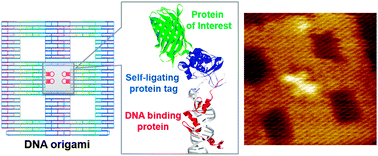
Chem. Commun., 2015,51, 1016-1019
https://doi.org/10.1039/C4CC08167F
Thermo-responsive white-light emission based on tetraphenylethylene- and rhodamine B-containing boronate nanoparticles
White-light emissive boronate nanoparticles have been prepared, which exhibit reversible and thermo-responsive emission in the investigated temperature range (5–65 °C) with a temperature sensitivity of 1.1% K−1 in water.

Chem. Commun., 2015,51, 118-121
https://doi.org/10.1039/C4CC07405J
Live cell off-target identification of lapatinib using ligand-directed tosyl chemistry
We demonstrate that ligand-directed tosyl (LDT) chemistry is applicable to off-target identification in live cells.
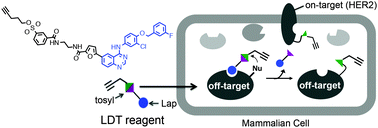
Chem. Commun., 2014,50, 14097-14100
https://doi.org/10.1039/C4CC05885B
Blending conjugated polymers without phase separation for fluorescent colour tuning of polymeric materials through FRET
Conjugated polymers encapsulated by the identical cyclic sidechains afford an effective host–guest ensemble for designing fluorescent polymeric materials.
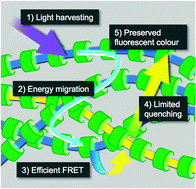
Chem. Commun., 2014,50, 11814-11817
https://doi.org/10.1039/C4CC03594A
Ditopic boronic acid and imine-based naphthalimide fluorescence sensor for copper(II)
Copper ions are essential for many biological processes.
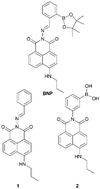
Chem. Commun., 2014,50, 11806-11809
https://doi.org/10.1039/C4CC03453H
19F NMR indicator displacement assay using a synthetic receptor with appended paramagnetic relaxation agent
A 19F NMR indicator displacement assay detects phosphorylated analytes with amplified signal intensity.
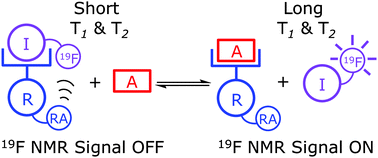
Chem. Commun., 2014,50, 10499-10501
https://doi.org/10.1039/C4CC04159C
Guest-induced supramolecular chirality in a ditopic azoprobe–cyclodextrin complex in water
The novel supramolecular sensors induced by the clockwise twisted structures due to multi-point recognition in water.
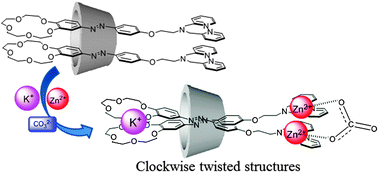
Chem. Commun., 2014,50, 10059-10061
https://doi.org/10.1039/C4CC04227A
Pseudorotaxane orientational stereoisomerism driven by π-electron density
Pseudo[2]rotaxane orientational isomers can be stereocontrolled by exploiting the electron-withdrawing or electron-donating effects of para-substituted dibenzylammonium axles threaded through a calix-wheel.
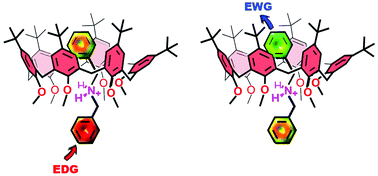
Chem. Commun., 2014,50, 9917-9920
https://doi.org/10.1039/C4CC04668D
Real-time fluorescence visualization of slow tautomerization of single free-base phthalocyanines under ambient conditions
Defocused wide-field fluorescence microscopy visualized slow tautomerization of the emission transition dipole moment of single H2Pc at an air/glass interface.
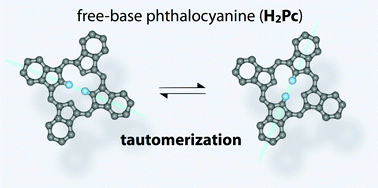
Chem. Commun., 2014,50, 9443-9446
https://doi.org/10.1039/C4CC02574A
The self-assembly and secondary structure of peptide amphiphiles determine the membrane permeation activity
New GALA-related peptide amphiphiles were designed and the influence of their self-assembling propensity and the secondary structure on the membrane permeability was studied.
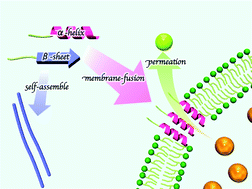
RSC Adv., 2014,4, 30654-30657
https://doi.org/10.1039/C4RA02901A
Nitrate anion templated synthesis of a [2]catenane for nitrate recognition in organic–aqueous solvent media
The first example of a catenane synthesised using a nitrate anion template is demonstrated. The resulting interlocked host is capable of selectively recognising nitrate over a range of more basic oxoanions in a competitive organic–aqueous solvent mixture.
![Graphical abstract: Nitrate anion templated synthesis of a [2]catenane for nitrate recognition in organic–aqueous solvent media](/en/Image/Get?imageInfo.ImageType=GA&imageInfo.ImageIdentifier.ManuscriptID=C4CC03200D&imageInfo.ImageIdentifier.Year=2014)
Chem. Commun., 2014,50, 8124-8127
https://doi.org/10.1039/C4CC03200D
Hoechst tagging: a modular strategy to design synthetic fluorescent probes for live-cell nucleus imaging
Attachment of the Hoechst tag to fluorescent molecules allows the creation of (turn-on) fluorescent nucleus-imaging probes.
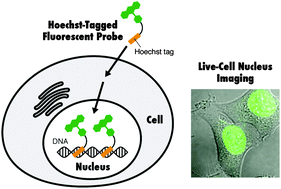
Chem. Commun., 2014,50, 6149-6152
https://doi.org/10.1039/C4CC01753F
INHIBIT logic operations based on light-driven β-cyclodextrin pseudo[1]rotaxane with room temperature phosphorescence addresses
INHIBIT logic gates based on light-driven β-cyclodextrin pseudo[1]rotaxane were fabricated conveniently utilizing reversible ICD and RTP as output addresses respectively.
![Graphical abstract: INHIBIT logic operations based on light-driven β-cyclodextrin pseudo[1]rotaxane with room temperature phosphorescence addresses](/en/Image/Get?imageInfo.ImageType=GA&imageInfo.ImageIdentifier.ManuscriptID=C3CC49820D&imageInfo.ImageIdentifier.Year=2014)
Chem. Commun., 2014,50, 3224-3226
https://doi.org/10.1039/C3CC49820D
Self-assembly formation of mechanically interlocked [2]- and [3]catenanes using lanthanide ion [Eu(III)] templation and ring closing metathesis reactions
The development of first examples of [2]- and [3]catenanes using lanthanide directed synthesis is described, which was analysed by NMR, UV-vis, luminescent spectroscopies as well as by HRMS.
![Graphical abstract: Self-assembly formation of mechanically interlocked [2]- and [3]catenanes using lanthanide ion [Eu(iii)] templation and ring closing metathesis reactions](/en/Image/Get?imageInfo.ImageType=GA&imageInfo.ImageIdentifier.ManuscriptID=C3CC49640F&imageInfo.ImageIdentifier.Year=2014)
Chem. Commun., 2014,50, 2857-2860
https://doi.org/10.1039/C3CC49640F
A bispyrene derivative as a selective fluorescent probe for RNA
A novel bispyrene compound was synthesized to selectively detect RNA through excimer emission “turn-on” at physiological pH.
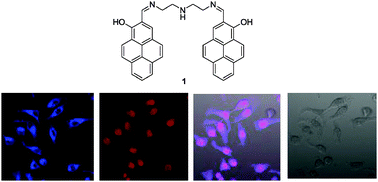
Chem. Commun., 2014,50, 2505-2507
https://doi.org/10.1039/C3CC49430F
Coordination ligand exchange of a xanthene probe–Ce(III) complex for selective fluorescence sensing of inorganic pyrophosphate
A fluorescence sensing system for inorganic pyrophosphate based on ligand exchange of the Ce(III) complex of a xanthene-type probe is developed.

Chem. Commun., 2014,50, 2126-2128
https://doi.org/10.1039/C3CC48101H
A near-infrared colorimetric fluorescent chemodosimeter for the detection of glutathione in living cells
A novel near-infrared (NIR) and colorimetric fluorescent molecular probe based on a dicyanomethylene-4H-pyran chromophore for the selective detection of glutathione in living cells has been developed.
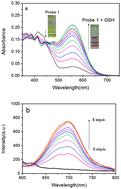
Chem. Commun., 2014,50, 1751-1753
https://doi.org/10.1039/C3CC48128J
Dynamic behaviour of giant unilamellar vesicles induced by the uptake of [70]fullerene
We have directly observed the processes involved in a C70-exchange reaction from γ-cyclodextrin cavities to lipid membranes using GUVs by phase contrast microscopy.
![Graphical abstract: Dynamic behaviour of giant unilamellar vesicles induced by the uptake of [70]fullerene](/en/Image/Get?imageInfo.ImageType=GA&imageInfo.ImageIdentifier.ManuscriptID=C3CC47711H&imageInfo.ImageIdentifier.Year=2014)
Chem. Commun., 2014,50, 1288-1291
https://doi.org/10.1039/C3CC47711H
A novel surface-coated nanocarrier for efficient encapsulation and delivery of camptothecin to cells
In the present study, we developed a novel surface-coated nanocarrier (SCN) for efficient and stable encapsulation of a poorly water-soluble anticancer agent, camptothecin (CPT).
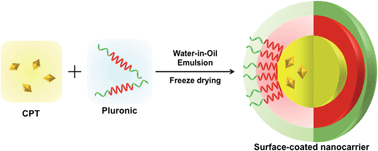
Med. Chem. Commun., 2014,5, 1515-1519
https://doi.org/10.1039/C4MD00179F
Amphiphilic benzothiadiazole–triphenylamine-based aggregates that emit red light in water
An amphiphilic donor–acceptor dye can provide red light emission in water in an aggregate state.
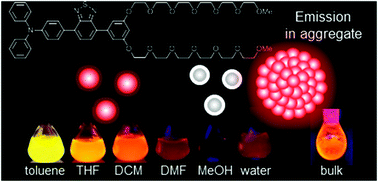
Org. Biomol. Chem., 2015,13, 1818-1828
https://doi.org/10.1039/C4OB02181A
Molecular recognition of upper rim functionalized cavitand and its unique dimeric capsule in the solid state
Calix[4]resorcinarene-based cavitand recognized the methyl group of the guests to form 1 : 1 host–guest complexes. In the solid state, the cavitand formed a dimeric capsule in which two molecules of nitromethane were entrapped by weak noncovalent interactions.
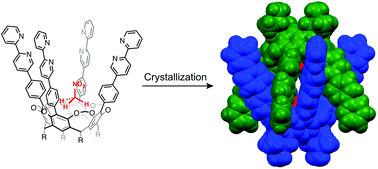
Org. Biomol. Chem., 2015,13, 1647-1653
https://doi.org/10.1039/C4OB02251C
A boronate hydrogel film containing organized two-component dyes as a multicolor fluorescent sensor for heavy metal ions in water
A boronate hydrogel film was developed as a multicolor fluorescent sensor for the visual determination of heavy metal ions.
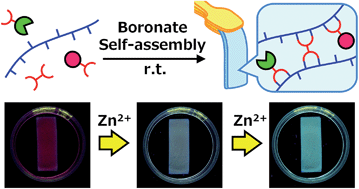
J. Mater. Chem. A, 2014,2, 15846-15852
https://doi.org/10.1039/C4TA03268C
Synthesis of a borylated boron–dibenzopyrromethene dye enabling the visual detection of H2O2 vapor
A boron–dibenzopyrromethene dye with a pinacolboryl group has been newly synthesized for the use as a reaction-based chemosensor. A TLC plate coated by the dye enables us to detect H2O2 vapor visually.

RSC Adv., 2014,4, 37973-37978
https://doi.org/10.1039/C4RA06061J
Guest induced head-to-tail columnar assembly of 5,17-difunctionalized calix[4]arene
Calix[4]arenes often form dimeric capsules or up-down bilayer arrangements in the solid state. The head-to-tail polymeric columnar structure found in the cocrystals composed of 5,17-difunctionalized calix[4]arene 1 and organic guests represents another structural motif for calix[4]arenes.
![Graphical abstract: Guest induced head-to-tail columnar assembly of 5,17-difunctionalized calix[4]arene](/en/Image/Get?imageInfo.ImageType=GA&imageInfo.ImageIdentifier.ManuscriptID=C4CE00667D&imageInfo.ImageIdentifier.Year=2014)
CrystEngComm, 2014,16, 6023-6032
https://doi.org/10.1039/C4CE00667D
Boronate microparticle-supported nano-palladium and nano-gold catalysts for chemoselective hydrogenation of cinnamaldehyde in environmentally preferable solvents
An efficient chemoselective hydrogenation of cinnamaldehyde over boronate microparticle-supported nano-palladium and nano-gold catalysts under environmentally benign conditions is reported.

Green Chem., 2014,16, 3230-3236
https://doi.org/10.1039/C4GC00383G
A novel strategy to design latent ratiometric fluorescent pH probes based on self-assembled SNARF derivatives
We describe a rational design strategy to develop a latent ratiometric fluorescent pH probe from self-assembled SNARF derivatives in aqueous conditions.

RSC Adv., 2014,4, 348-357
https://doi.org/10.1039/C3RA43928C
A bis-boronic acid modified electrode for the sensitive and selective determination of glucose concentrations
A bis-boronic acid modified electrode for the sensitive and selective determination of glucose concentrations has been developed.
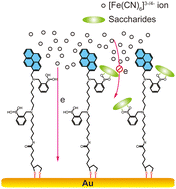
Analyst, 2013,138, 7146-7151
https://doi.org/10.1039/C3AN01234D
Glucose selective Surface Plasmon Resonance-based bis-boronic acid sensor
Surface plasmon resonance and self-assembled monolayers on gold generated from a bis-boronic acid can detect glucose with higher affinity than other saccharides, namely galactose, fructose and mannose.
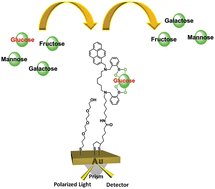
Analyst, 2013,138, 7140-7145
https://doi.org/10.1039/C3AN01233F
About this collection
We are delighted to present this collection of articles that have been dedicated to Professor Seiji Shinkai on the occasion of his 70th birthday. This special collection has been organised by Tony James, Itaru Hamachi and Kazuo Sakurai. New articles will be added to this collection as they are published.